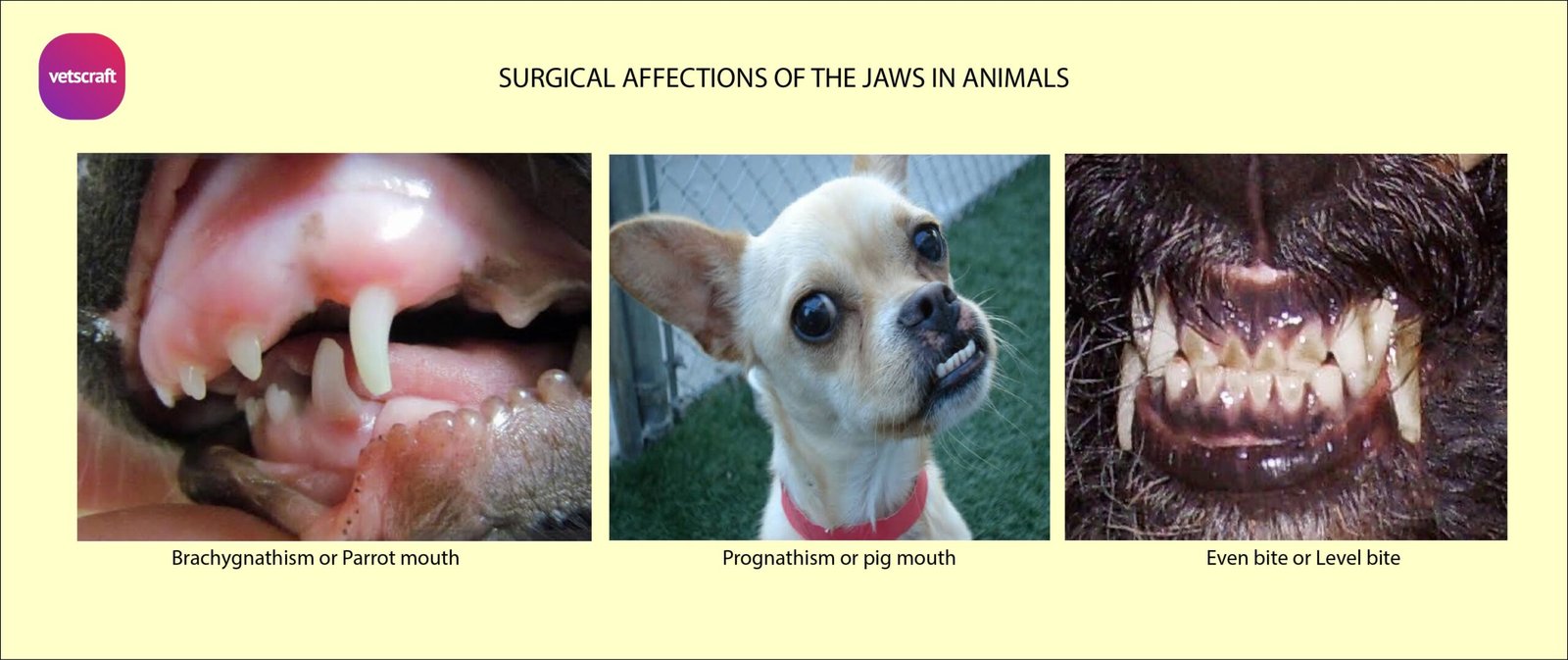TABLE OF CONTENTS
Surgical affections of the Jaws
Surgical affections of the Jaws in animals are Brachygnathism or Parrot mouth, Prognathism or pig mouth, Even bite or level bite, Craniofacial Dysplasia, Fracture of maxilla and mandible etc.
Surgical affections of the Jaws in animals are–
- Brachygnathism or Parrot mouth
- Prognathism or pig mouth
- Even bite
- Craniofacial Dysplasia
- Fracture of maxilla
- Fracture of mandible
Brachygnathism or Parrot mouth
The upper jaw is substantially longer than the lower jaw and deep palatal defects have developed in Brachygnathism or Parrot mouth. This condition is also called overbite.
Brachygnathism or Parrot mouth commonly seen in equines.
Prognathism or pig mouth
The lower jaw is substantially longer than the upper jaw in case of Prognathism or pig mouth or hog mouth. This is also called under bite.
Prognathism or pig mouth commonly seen in dogs.
Even bite
Lower and upper incisor meet edge to edge in case of even bite or level bite.

Craniofacial Dysplasia
Craniofacial Dysplasia is characterized by convex profile of the nose, shorter lower jaw, deficient ossification of frontal sutures, exophthalmos and large tongue in Limousin breed of cattle.
It is due to homozygosity through a recessive gene.
Fracture of maxilla
Fracture of the superior maxilla and premaxilla are common surgical affections due to trauma in animals.
Etiology of maxilla fracture
Direct violence, collision, striking the head violently against a hard fixed object, falling forward on the nose, or by a kick or blow etc.
Fracture of maxilla may be transverse, longitudinal, or both, unilaternal or bilateral.
Treatment of maxilla fracture
Loose teeth may become fixed in a few days and hence need not be removed. If suppuration occurs in their alveoli, loose teeth should not be removed. Semi liquid diet should be advised.
Follow the general principles for wounds and fractures.
Retention is best effected by means of inter dental wiring of the adjacent teeth, mini plating, and by external skeletal fixation with methyl methacyrlate.
Fracture of mandible
Etiology of mandible fracture
Kicks falls or direct violence, repulsion of tooth, site of fracture can be on body, one or two rami of the mandible bone, the condyle or coronoid process.

Treatment of mandible fracture
Fracture through symphysis
Replace the fragments in their normal position and maintain them by joining the teeth on either side by wire. In dogs the two jaws can be fixed by bandage.
Fracture through one side of body
Reduce the fracture; wire the teeth, so as to make the affected side intact. Bones may be united by wire sutures.
Transverse fracture through the body or through both rami near the symphysis
Wiring incisors to the first molars may be useful in conjunction with an apparatus to form a ‘V’ fixed to the lower jaw.
The apex ‘v’ being spoon-shaped to support the chin and its branches being grooved to adapt themselves to the horizontal rami.
Wire sutures through the bone are the best means of immobilising the seat of fracture. In condition of necrosis of bone, amputation may be done.
Fracture of ramus on one side
Requires no treatment, because of rare chance of displacement.
A blister may be applied on the skin at the level of fracture. Blister cause additional inflammation and hyperemia, which hastens the healing process.
In all cases of fracture of jaws, soft easily masticated food is indicated.